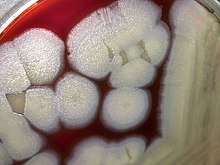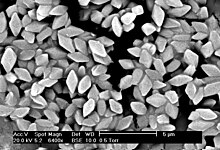Bacillus thuringiensis
| Bacillus thuringiensis | ||||||||||||
|---|---|---|---|---|---|---|---|---|---|---|---|---|
| Systematics | ||||||||||||
|
||||||||||||
| Scientific name | ||||||||||||
| Bacillus thuringiensis | ||||||||||||
| Berliner , 1915 |

Bacillus thuringiensis is a bacterium that can be found mainly in the soil, but also on plants and in insect carcasses. The Bt toxins produced by the bacteriumare used for biological pest control in agriculture and forestry and in the control of disease-transmitting mosquitoes .
description

Like the other species in the genus Bacillus, Bacillus thuringiensis is rod-shaped and gram-positive . It forms permanent stages in the form of spores. It was founded in 1901 in Japan by Ishiwatari Shigetane ( Japanese 石 渡 繁 胤 ) as Bacillus sotto (from Japanese 卒 倒 sottō , German 'collapse, collapse' , today B. thuringiensis var. Sotto .) And in 1911 by Ernst Berliner (1880–1957) described in Germany, who gave it the name Bacillus thuringiensis . Ishiwatari Shigetane found bacillus in silkworms, Ernst Berliner discovered it in flour moth caterpillars from a mill in Thuringia . He also recognized that this bacterium triggers what is known as sleep addiction in flour moth larvae . The different subspecies of B. thuringiensis produce over 200 different so-called Bt toxins, which are specifically fatal to certain insects.
B. thuringiensis lives in company with plant roots. It is believed that the bacterium's toxins protect the roots from damage by insects.
B. thuringiensis is closely related to Bacillus cereus and differs from this bacterium only - like Bacillus anthracis - by so-called plasmids . Like all other Bacillus species, they are aerobic and form endospores .
Bt toxin

B. thuringiensis produces crystalline proteins (Bt toxins, see figure), which have a specific toxic effect on various insect species of the orders beetles , butterflies , hymenoptera and flyworms as well as nematodes , in plants, vertebrates such as z. B. Humans are ineffective. They are completely biodegradable .
The genetic information for the Bt toxins is on plasmids . Depending on the strain , these express one or more different so-called Cry and Cyt proteins, which differ in terms of their toxicity towards the various insect orders. There are more than 200 different Cry proteins. These toxic crystal proteins must first be dissolved in the insect intestine and activated by a specific enzymatic cleavage of subunits before they can develop their effect. The amount and type of proteins varies from strain to strain. Cyt and Cry proteins attach to intestinal cells and create pores in the cell membrane, thereby destroying the intestinal cell. In order for this to happen, the respective toxins have to find specific attachment points on the cell membrane, which explains their specific action against certain insects.
Applications
Bt toxins are used in horticulture, agriculture and forestry as pesticides and for combating mosquitoes . They can be used to fight frostbite or boxwood moth. Since the preparations only work against caterpillars, other living beings are not in danger.
Agriculture

Bt toxins have been used in agriculture since 1938, but have not achieved great importance in this form. In contrast, the areas under cultivation for Bt plants have grown rapidly since they were first approved in 1996.
Bt suspensions
In organic agriculture in particular , Bt toxins are used in the form of suspensions against free-eating caterpillars. This drug has been used in France since 1938 and in the United States since 1950. Today different Bt toxins are used against different insects.
B. thuringiensis israelensis is used in mosquito control. The mosquitoes are fought in the larval stage in the waters. The effects on other insect larvae, such as mosquitoes, are minor.
Other subspecies used are B. thuringiensis kurstaki (Btk), B. thuringiensis aizawa , B. thuringiensis san diego , and B. thuringiensis tenebrionis . As with other pesticides , the target organisms can develop resistance after a longer or shorter period of use. In relation to Bt toxins, this was first observed in the cabbage moth at the end of the 1980s .
Bt plants
→ Main articles: Green genetic engineering , transgenic cotton , transgenic maize
Genes transferred from Bacillus thuringiensis to crops mean that the plants produce Bt toxins on their own. This so-called Bt concept has been used since 1996 and primarily for maize and cotton .
forestry
One of the most successful applications of Bt toxins so far is the control of forest pests of the order butterflies , which cause great damage , especially in North American coniferous forests . The use of Bt toxins led to a significant reduction in the use of chemical insecticides in forestry. In Germany, Bt preparations have been used locally on a large scale to combat the oak processionary moth for years .
Control of mosquitoes
Bt toxins of the subspecies B. thuringiensis israelensis are toxic to various species of the genera Aedes , Culex and Anopheles , which are disease carriers. In particular, populations of carriers of diseases such as dengue fever , onchocerciasis and malaria can be decimated in this way. A program to combat onchocerciasis has been implemented in West Africa since 1983, 80% of which is based on the use of Bt toxins. An estimated 15 million children have been protected from the disease. No development of resistance has been documented in mosquitoes.
Taxonomy
Through genetic studies it was shown that it is in the biopesticide Bacillus thuringiensis , the anthrax bacillus anthracis and the food poisoning Bacillus cereus are variations of a single species. Whether Bacillus thuringiensis actually causes diarrhea or other diseases has not yet been conclusively clarified.
Web links
- N. Crickmore, DR Zeigler, E. Schnepf, J. Van Rie, D. Lereclus, J. Baum, A. Bravo, DH Dean: Bacillus thuringiensis Toxin Nomenclature . 2011 (online) .
- Video: Bacillus thuringiensis (Bacillaceae) - Vegetative reproduction and spore formation . Institute for Scientific Film (IWF) 1963, made available by the Technical Information Library (TIB), doi : 10.3203 / IWF / E-555 .
Individual evidence
- ^ Edward Steinhaus: Insect Pathology: An Advanced Treatise . Elsevier, 2012, ISBN 978-0-323-14317-2 , p. 32: “ Bacillus sotto Ishiwata [→] Taxonomic reassignment: Bacillus thuringiensis var. Sotto Ishiwata . [Heimpel and Angus, 1960] "
- ↑ Renate Kaiser-Alexnat (Julius Kühn Institute, Federal Research Institute for Cultivated Plants (JKI), Institute for Biological Plant Protection, Darmstadt): Bacillus thuringiensis ( Memento from June 26, 2011 in the Internet Archive ) (PDF file, German; 461 kB).
- ^ Murray W. Nabors: Botany. Pearson Studium, ISBN 978-3-8273-7231-4 , pp. 354f.
- ↑ a b c d A. Bravo, SS Gill, M. Soberón: Mode of action of Bacillus thuringiensis Cry and Cyt toxins and their potential for insect control. In: Toxicon . Volume 49, Number 4, March 2007, pp. 423-435, ISSN 0041-0101 . doi: 10.1016 / j.toxicon.2006.11.022 . PMID 17198720 . PMC 1857359 (free full text).
- ↑ K. Frederiksen, H. Rosenquist, K. Jørgensen, A. Wilcks: Occurrence of natural Bacillus thuringiensis contaminants and residues of Bacillus thuringiensis-based insecticides on fresh fruits and vegetables. In: Applied and environmental microbiology. Volume 72, Number 5, May 2006, pp. 3435-3440, ISSN 0099-2240 . doi: 10.1128 / AEM.72.5.3435-3440.2006 . PMID 16672488 . PMC 1472320 (free full text).
- ↑ Bruce E. Tabashnik, Naomi Finson, James M. Schwartz, Michael A. Caprio, Marshall W. Johnson: Diamondback Moth Resistance to Bacillus thuringiensis in Hawaii . Ed .: Department of Entomology, University of Hawaii. ( cornell.edu [PDF; 566 kB ]).
- ↑ J. Romeis, M. Meissle, F. Bigler: Transgenic crops expressing Bacillus thuringiensis toxins and biological control. In: Nature biotechnology . Volume 24, Number 1, January 2006, pp. 63-71, ISSN 1087-0156 . doi: 10.1038 / nbt1180 . PMID 16404399 . (Review).
- ↑ E. Helgason, OA Okstad, DA Caugant, HA Johansen, A. Fouet, M. Mock, I. Hegna, AB Kolstø: Bacillus anthracis, Bacillus cereus, and Bacillus thuringiensis - one species on the basis of genetic evidence. In: Applied and environmental microbiology. Volume 66, Number 6, June 2000, pp. 2627-2630, ISSN 0099-2240 . PMID 10831447 . PMC 110590 (free full text).
- ↑ Ben Raymond, Brian A. Federici: In defense of Bacillus thuringiensis, the safest and most successful microbial insecticide available to humanity — a response to EFSA . In: FEMS Microbiology Ecology . tape 93 , no. 7 , July 1, 2017, ISSN 0168-6496 , doi : 10.1093 / femsec / fix084 ( oup.com [accessed November 23, 2017]).